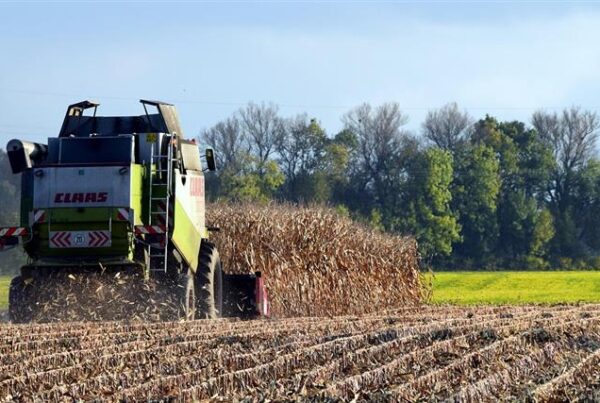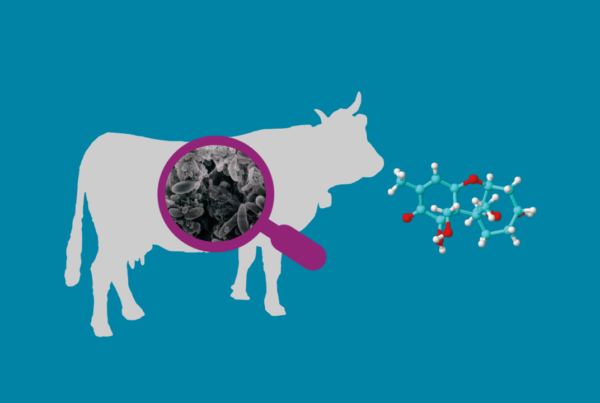An insight into one of the most devastating animal diseases in recent years.
The recent spreading of the African Swine Fever (ASF) in China and its accompaniment of a devastating mortality and disastrous economic penalties has become a major concern across the pig producing communities over South East Asia. Indeed, the speed of the contagion of ASF is extremely fast and several neighboring countries such as Vietnam or Thailand have been affected by this disease.
What is the ASF?
ASF – African Swine Fever is a highly contagious hemorrhagic disease affecting exclusively domestic or wild pigs. ASF can affect without any discrimination all age groups and sex groups of swine. ASF is conducted by a very virulent and very resistant DNA virus from the Asfarviridae Family (22 serotypes). The on-set of the infection is very fast with a DPI (Days-post-infection) of 3 to 5 days.
The ASF virus has remarkable ability to survive for long periods in protein rich environments, such as meat products, pork tissues or body fluid (6 months to 5 years). Also, the disease can even remain alive in the lymph of the few survivors and decomposing carcasses of dead pigs can be a source of contamination for scavengers.
Meat from pigs slaughtered in the early stages of contamination provides a very virulent source of the virus. Fresh, frozen-pork, smoked or dried pork can be infective carriers of ASF virus.
Moreover, the virus is not affected by meat maturation processes. Only a process of 20 minutes at the minimal temperature of 600C can inactivate the virus. ASF is characterized by a high fever (>410C), a loss of appetite, hemorrhages in the skin, cyanosis of the ears, internal bleeding and a devastating mortality (80 to 100%) within 2 to 10 days after the on-set of the contagion.
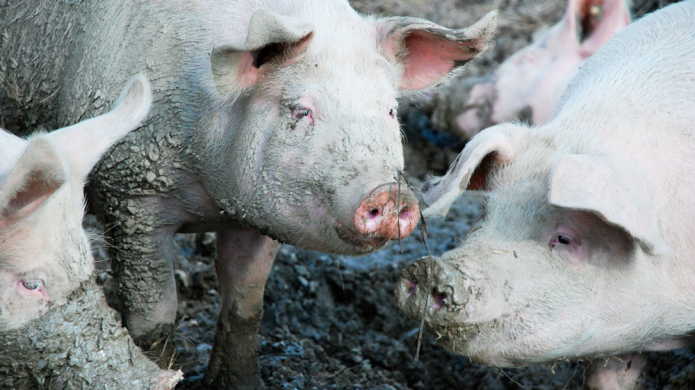
Swine farm.
What are the clinical signs or symptoms of ASF?
The clinical signs of ASF in its acute form include high fever (>410C) causing shivering, huddling together and heavy breathing, a loss of appetite, a depressed feed intake, vomiting, diarrhea or constipation, skin hemorrhages, under the skin bleeding, bleeding nostrils, congested red mucus membranes (eyes) and at its fatal stage a comatose state leading to death.
What are the modes of contamination of ASF?
There are two modes of contaminations: a direct contamination and an indirect contamination.
The direct contamination is caused by contact between sick animals and healthy animals, either being domestic or wild. The indirect contamination can be caused by feeding the swine on infected swill food, garbage and any pork product contaminated by ASF. Most of outbreaks of ASF in the world have resulted from this mode of contamination.
The ASF virus can be carried as well by soft ticks, as they are able to retain the virus for at least 5 years and transmit it to susceptible animals. Flies and mosquitoes have been found to carry ASF as well. Body fluids such as saliva, blood, semen and urine are lethal carriers of ASF. Slurries produced by infected pigs can retain and carry ASF for many months.
The spreading of ASF is carried by contaminated means of transport, trucks, cars, motorbikes, bikes, but as well by domestic animals carrying contaminated matters on their footpads. Out of all, one of the most dangerous carriers of ASF remain the human who through a lack of care and discipline can disseminate viral particles in fomites (contaminated clothes, shoes, equipment, mobile phones) and in food (pork based sandwiches…).
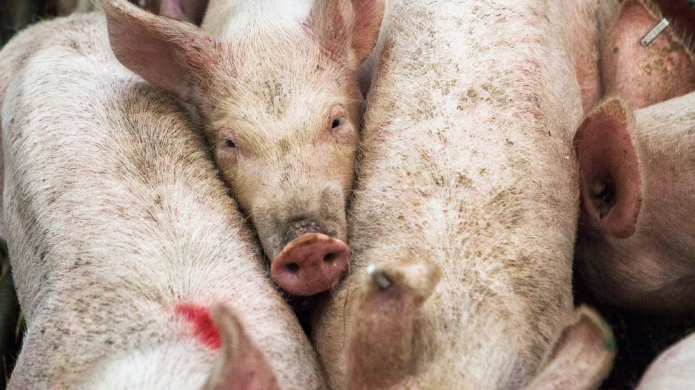
Swine farm.
Why is this swine fever called African?
The first outbreak of ASF was reported in 1907 in Kenya. ASF was found to be transmitted from warthogs and bush pigs to domestic pigs by soft ticks acting a vector of contamination. African swine fever is endemic in the sub-Saharan countries of Africa (Kenya, Angola, South-Africa…). The first spread of ASF outside Africa was to Portugal in 1957 as a result of the feeding of pork wastes from airline flights to pigs. Ever since, many outbreaks of ASF have been attributed to this mode of contamination, Italy (1967), Cuba (1971), Brazil (1978), Georgia (2007). Most recently from Poland to Belgium. In Mainland China many observers attribute the rapid-fire propagation of ASF to the feeding of contamination swill food from airlines garbage by backyard pig producers.
How can we diagnose ASF?
ASF may be suspected based on clinical signs but confirmation must be made through laboratory tests in order to differentiate the disease from classical swine fever, erysipelas, bacterial septicemias, salmonellosis and pasteurellosis. The detection of antibodies will not likely be possible in pigs that have died from acute ASF as they don’t usually have the time to produce antibodies due to the sudden nature of their death. Detection can be operated by ELISA or Virus Antigens by Polymerase Chain Reaction (PCR).
In the absence of vaccines, what can we do to prevent the incurrence of ASF?
Although several research projects on an effective vaccine are on the way, currently there is no treatment and no cure for ASF. So, prevention is the absolute necessity.
Prevention calls on a strict bio-exclusion and biosecurity. The farm shall be physically closed by walls to prevent access to feral animals, stray dogs and cats. Farm workers shall stay on farm and a strict decontamination shall be conducted on their return. Farm access to visitors shall be prohibited. Farm access to vehicles shall be controlled, minimized and sanitized. Pork shall not be introduced in the farm. Disinfection shall be optimal. Hot air sanitation shall be performed on trucks. In Mainland China, many of the hot air blower units have been installed immediately within the vicinity of the farms, in order to sanitize vehicles used for the transportation of the animals.
Therefore, the choice of a very effective antiviral disinfectant is absolutely critical. And disinfectant should be given enough time of contact (up to 30 minutes) to perform their sanitation. The management of infection should be made aware of all farm workers and visitors.
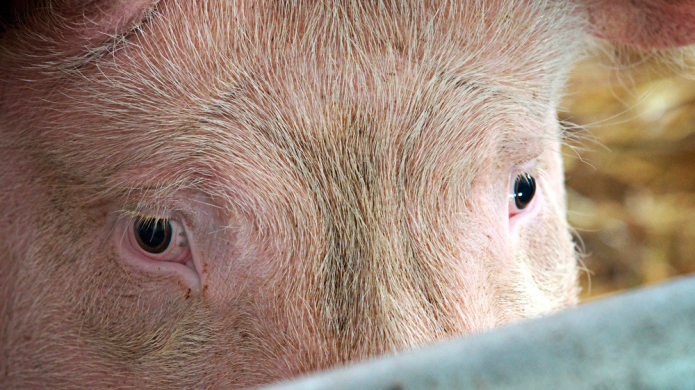
Swine farm.
Tools to face the ASF
As exhaustive prevention, bio-exclusion and bio-security measures are to be taken to tackle this challenge, experts in Olmix suggest to follow a two-step plan to first protect the environment of the animals on the farm and then reinforce the immune system, aiming at prevention.
Mistral®, to sanitize the animals’ environment
Used for more than 20 years in swine farms, Mistral® is a desiccant product used by the farmers as an environmental management tool to ensure animals’ comfort, hygiene and performance.
Mistral® is made up of a fine selection of essential oils and clays association micronized according to a specific grinding process. The product’s extra-fine particles allow high drying capacity to reduce the risk of pathogens development in the animals’ environment. Its application in swine farms has already demonstrated the improvement of the profitability of the farm by improving performances especially through the increased survival rate of piglets and the reduction of the pathogenic pressure. Hence, as an efficient environmental management tool, Mistral® is part of the hygienization and biosecurity strategies in farms.

Algimun® to boost gut integrity and the immune function of animals
Immunity has been identified as a priority for farmers and producers as it is the challenge of modern productions. Proper immune response is a key to make animals healthier and better able to face daily challenges.
Based on a synergistic association of biologically active sulfated polysaccharides extracted from marine algae (Olmix MSP®), Algimun® continually reinforces animals’ natural defences to make them more robust, and resistant to everyday stress. The product reinforces both the integrity of the intestinal wall to prevent pathogens to cross intestinal barrier and the immune mechanisms allowing better and quicker response in case of stress.
In recent trials in the field, Algimun® has proved to sharply improve sow immune transfer to piglet hence their resistance and performance.

Conclusion
African swine fever is a devastating disease which cause major economic losses, threatens food security and limits production of a valuable and effective source of protein. The propagation of ASF challenges the responsibility of all the actors within the pig production sector; the suppliers of breeding stock, the farmers, the employees of the farm, the veterinarians, the feed manufacturers and beyond…. the general public. Biosecurity measures along with a strong immune system are essential to contain ASF and to support repopulation strategy.

